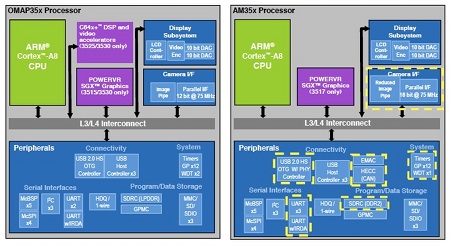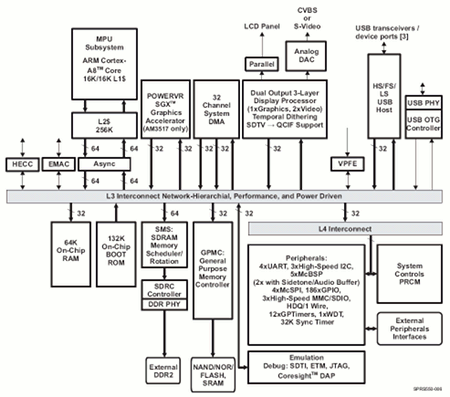Cortex-A8 processors target industrial applications
Oct 21, 2009 — by LinuxDevices Staff — from the LinuxDevices Archive — 7 viewsTexas Instruments (TI) announced two Linux-compatible, Cortex A8-based processors that are based on its OMAP35x SoCs, but aimed at the industrial market. The Sitara AM3505 and AM3517 run at 500MHz while using less than one Watt, include 10/100 Ethernet, support DDR2 memory, and offer CAN controllers, according to the company.
TI says its new AM3505 and AM3517 are generally similar to the OMAP35x application processors it announced last year, but lacks their video acceleration DSPs (digital signal processors). Like those system-on-chips (SoCs) — the OMAP3503, OMAP3515, OMAP3525, and OMAP3530 — the AM35x products employ ARM Cortex-A8 cores along with a variety of integrated peripherals.
The AM35x products are, in turn, architecturally similar to TI's earlier OMAP34x processors, which also use Cortex-A8 cores. But, where the 34x products are aimed at cellular phones and MIDs (mobile internet devices), and the 35x products are aimed at PNDs (personal navigation devices), PMPs (portable media players), and digital video cameras, the new AM35x CPUs have an industrial focus, according to TI. Expected uses include automation, "smart white goods," digital signage, medical, and in-dash navigation applications, the company adds.

A comparison between the OMAP35x (left) and AM35x (right)
Source: TI
(Click to enlarge)
According to TI, the AM3505 and AM3517 are distinguished by their support of lower-cost DDR2 memory, instead of the LPDDR required by the OMAP35x products. The AM35x chips also add 10/100 Ethernet controllers, provide PHY (physical layer) functionality for their USB 2.0 on-the-go interfaces, and include high-end CAN controllers, the company says. These newly integrated peripherals can result in a $10 reduction in overall system cost, the company says.
Among other differences, the AM35x clocks the Cortex-A8 core to 500MHz instead of 600MHz (or 720MHz for the new OMAP3530 Rev E), and it supports only a 26MHz system clock vs. the 12, 19.2, 26, and 32MHz clocks supported by the OMAP35x, TI says. Additionally, I/O may be either 3.3 or 1.8 Volt, as opposed to the OMAP35x, which is said to support 1.8-Volt I/O only.
Like the OMAP35x, the AM3505 and AM3517 include a display subsystem offering picture-in-picture, color space conversion, rotation, and resizing support, according to TI. The AM3517 adds the same Imagination PowerVR SGX graphics accelerator that is found on the OMAP3515 and OMAP3530, the company says.

A block diagram of TI's AM3517
(Click to enlarge)
According to TI, neither AM35x part offers the TMS320C64x+ DSP that's found on the OMAP3525 and OMAP3530, so HD video decoding is not part of the mix. Also, while video capture is still offered, it has "reduced functionality," according to the chipmaker.

TI's TMDXEVM3517 EVM (evaluation module)
(Click to enlarge)
TI says it is offering a TMDXEVM3517 EVM (evaluation module), pictured above, that includes an AM3517 SOM (system on module) with 256MB of DDR memory, 512MB of flash storage, and a touchscreen display. The EVM, whose measurements were not specified, also includes a baseboard with real-world connectors for Ethernet, USB, CAN, SDIO, I2C, JTAG, and HDMI. Wireless networking, Bluetooth, and a video input are also onboard, the company adds.
Availability
According to TI, the TMDXEVM3517 is available now for approximately $1,000, including a Linux SDK. Windows CE support will be offered during the fourth quarter, the company adds.
The AM3505 and AM3517 are said to be sampling now in both 0.65mm and 1mm BGA (ball grid array packages), priced at $21.45 and $25, respectively, in quantities of 1,000.
Further information on the AM3505 and AM3517 may be found on TI's website, here.
This article was originally published on LinuxDevices.com and has been donated to the open source community by QuinStreet Inc. Please visit LinuxToday.com for up-to-date news and articles about Linux and open source.